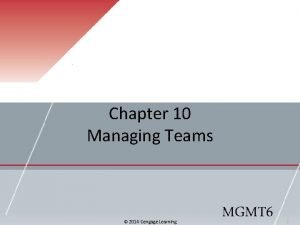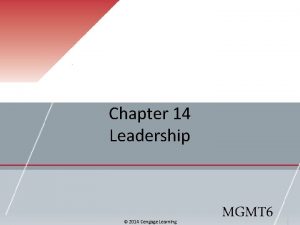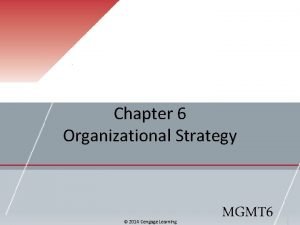Chapter 10 Managing Teams 2014 Cengage Learning MGMT















- Slides: 15

Chapter 10 Managing Teams © 2014 Cengage Learning MGMT 7

10 -1 explain the good and bad of using teams 10 -2 recognize and understand the different kinds of teams 10 -3 understand the general characteristics of work teams 10 -4 explain how to enhance work-team effectiveness © 2014 Cengage Learning

The Advantages of Teams improve… • • Customer satisfaction Product and service quality Product development speed and efficiency Employee job satisfaction – Cross-training • Decision making © 2014 Cengage Learning 10 -1

The Disadvantages of Teams • Initially high turnover • Social loafing • Groupthink • Minority domination © 2014 Cengage Learning 10 -1

When to Use and When Not to Use Teams © 2014 Cengage Learning 10 -1

Team Autonomy Continuum © 2014 Cengage Learning 10 -2

Special Kinds of Teams • Cross-functional teams • Virtual teams • Project teams 10 -2 © 2014 Cengage Learning

Work Team Characteristics • Team norms • Team cohesiveness • Team size • Team conflict • Stages of team development © 2014 Cengage Learning 10 -3

Having a Good Fight • • • 10 -3 Work with more, not less, information Develop multiple alternatives to enrich debate Establish common goals Inject humor into the workplace Maintain a balance of power Resolve issues without forcing a consensus © 2014 Cengage Learning

Stages of Team Development © 2014 Cengage Learning 10 -3

Setting Team Goals and Priorities • Increasing a team’s performance is inherently more complex than just increasing one person’s performance. • Challenging team goals affect how hard team members work. 10 -4 © 2014 Cengage Learning

Stretch Goals Extremely ambitious goals that workers don’t know how to reach. • Teams must have a high degree of autonomy • Teams must be empowered with control over resources • Structural accommodation • Bureaucratic immunity © 2014 Cengage Learning 10 -4

Selecting People • Individualists – put their own welfare and interests first • Collectivists – put group interests ahead of self • Team level – the average level of ability, experience, personality, or any other factor on a team • Team diversity – variances or differences in ability, personality, or any other factor on a team © 2014 Cengage Learning 10 -4

Team Training • Interpersonal skills • Decision making skills • Problem solving skills • Conflict resolution skills • Technical training © 2014 Cengage Learning 10 -4

Team Compensation • Skill-based pay – pay employees for learning additional skills or knowledge • Gainsharing – companies share the financial value of performance gains with their workers • Nonfinancial rewards – vacations, T-shirts, awards, certificates 10 -4 © 2014 Cengage Learning
 2014 cengage learning accounting answers
2014 cengage learning accounting answers 2014 cengage learning
2014 cengage learning Chapter 13 medical math assignment sheet
Chapter 13 medical math assignment sheet Chapter 7:10 respitory system
Chapter 7:10 respitory system Understanding groups and teams
Understanding groups and teams 2009 delmar cengage learning
2009 delmar cengage learning Chapter 5 the cardiovascular system
Chapter 5 the cardiovascular system Cengage learning heart diagram
Cengage learning heart diagram South-western cengage learning
South-western cengage learning 2009 delmar cengage learning
2009 delmar cengage learning Cengage learning heart diagram
Cengage learning heart diagram Medical terminology chapter 1 learning exercises answers
Medical terminology chapter 1 learning exercises answers Cengage learning australia
Cengage learning australia 2009 delmar cengage learning
2009 delmar cengage learning Whille
Whille Cengage learning
Cengage learning





























